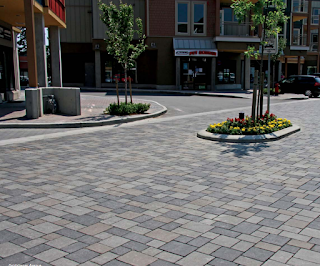Paving our way to green
 Segmental paving dates
back to the Roman Empire. Treating a road surface like a wall buried in the
earth, they created a series of primary and secondary roads that together
covered almost 200,000 miles (321,900 km). Built to last for a century, these
roads shared the characteristics of a straight path, gradual gradients, curved
surfaces for water run-off, curbs, and gutters. Often 6 feet (1.8 m) thick, the
primary roads consisted of a series of rock, stone, and gravel layers covered
with paving stones.
Segmental paving dates
back to the Roman Empire. Treating a road surface like a wall buried in the
earth, they created a series of primary and secondary roads that together
covered almost 200,000 miles (321,900 km). Built to last for a century, these
roads shared the characteristics of a straight path, gradual gradients, curved
surfaces for water run-off, curbs, and gutters. Often 6 feet (1.8 m) thick, the
primary roads consisted of a series of rock, stone, and gravel layers covered
with paving stones.
Today, asphalt covers
more than 94 percent of the paved roads in the United States; it’s the popular
choice for driveways, parking lots, airport runways, racetracks, tennis courts,
and other applications where a smooth, durable driving surface is required.
 Interlocking concrete
pavement (ICP) or permeable interlocking concrete pavement (PICP) consists of
manufactured concrete units that reduce stormwater runoff volume, rate, and pollutants. Placed in segmental
paving much like the Roman’s did, today’s version is made of precast,
high-strength concrete paving units. They are designed with small openings that
create permeable joints. The openings typically comprise 5% to 15% of the paver
surface area and are filled with highly permeable, small-sized aggregates. The
joints allow stormwater to enter a crushed stone aggregate bedding layer and
base that supports the pavers while providing storage and runoff treatment.
Interlocking concrete
pavement (ICP) or permeable interlocking concrete pavement (PICP) consists of
manufactured concrete units that reduce stormwater runoff volume, rate, and pollutants. Placed in segmental
paving much like the Roman’s did, today’s version is made of precast,
high-strength concrete paving units. They are designed with small openings that
create permeable joints. The openings typically comprise 5% to 15% of the paver
surface area and are filled with highly permeable, small-sized aggregates. The
joints allow stormwater to enter a crushed stone aggregate bedding layer and
base that supports the pavers while providing storage and runoff treatment.For more information about this sustainable approach to roads and paved surfaces, visit Interlocking Concrete Pavement Institute.
For more information about urban naturalization and how it relates to you, visit http://urbannatural.weebly.com/

Comments
Post a Comment
Let your knowledge, ideas, and innovation be heard. Tell us what you think and know about this topic.